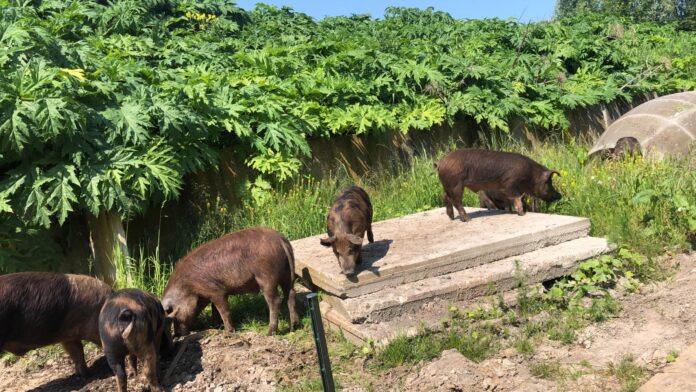Using pigs to combat Japanese knotweed and giant hogweed at Zernike is not working sufficiently, the UG feels. But how do you permanently get rid of those plants? That’s not so easy, says an expert.
The invasive weeds need to be dealt with soon. Now that spring has come, they will start to grow rapidly and if they are allowed to bloom, they will produce thousands of seeds and spread even further.
The pigs were a sustainable and clean method of managing the weeds, but are not the best way to eradicate the problem for good, agrees Chris van Dijk, who researches sustainable green management at Wageningen University and advises municipalities on how to deal with Japanese knotweed and other invasive species.
Years of treatment
There is no one-size-fits-all solution, he says. ‘The approach that is needed depends on where the weeds are growing, the time available, and what the end goal is.’ To add to the problem, Japanese knotweed and hogweed need to be dealt with differently.
It can take many years of treatment to fully deal with the plants. Organisations often start out very enthusiastic, Van Dijk says, but after a couple of years, they change tactics or stop altogether. ‘Then even more grows back.’
Mowing
Common guidelines for dealing with the hogweed suggest high-frequency mowing of the plants for a long period of time. ‘You have to continue until all the viable seeds have germinated and have been mowed away. That takes years’, says Van Dijk.
But mowing can be dangerous on a campus like Zernike, because hogweed can burn the skin, so you need to make a safety zone when doing it. And mowing Japanese knotweed can result in a faster spread of the plant, as the seeds can be dispersed.
Heating or freezing
The UG have said they are considering quicker approaches including heating the soil, freezing it, or flooding it. These are effective, says Van Dijk, but they are also expensive and use a lot of energy. ‘Sustainability is not really an issue in the discussion at this moment. Everybody’s just looking for an effective method.’
Meanwhile, these methods also kill all the plants that share the soil with the weeds. The good news is that they will grow back, because they are reintroduced naturally over time from their surroundings, says Van Dijk. The bad news: knotweed and hogweed can come back in the same way.
Excavation
Manual excavation – the method the municipality is using elsewhere – is the cleanest method for knotweed, but depending on how much land you have to dig up, that can be difficult. It is also labour intensive, and contaminated soil needs to be transported and treated at a depot.
The municipality is prioritising clearing built-up and high-risk areas like cycling paths and playgrounds. It is not clear if this includes Zernike or the areas around it, which is an issue because even if the campus is cleared, the weeds can still come back if the seeds can spread from areas close by.




